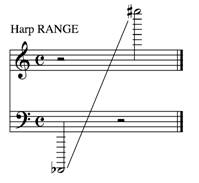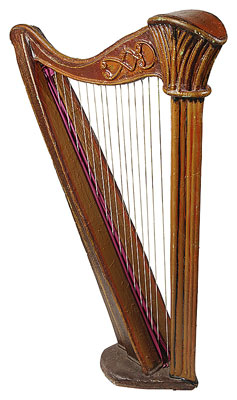Harp
Ancient civilizations developed early harps. Egyptians had harps as early as 3000 BC. Most likely, they were fashioned from a hunting bow with strings of different lengths stretched to produce different notes. However, other harp-like instruments have been found in Africa, China, South America, and Europe. It would seem that people from around the globe developed some kind of harp from the materials they had available.
Over time the harp became more sophisticated with the addition of additional strings and mechanisms that allowed the strings to be pulled tighter without slipping. This provided more accurate tuning that was less likely to change over time. This is very important if the harp is to be played with other instruments. They must share a common tuning and it must remain stable.

The modern harp has 46 strings with seven pedals. The pedals are used to tighten the strings to make it possible to produce different notes for different scales and keys. The pedals can be set to one of three positions. In the first position the string is open. Each of the two additional pedal positions raises the pitch a minor 2nd (1/2 step) at a time. The harp is played by plucking the strings with all of the fingers (except the little finger, which is usually too short and weak). The feet are used to operate the pedals.
Harps can be heard in symphony orchestras, small chamber music ensembles, studio orchestras, and weddings.
Study the image provided and listen to the sound sample of the harp to gain an understanding of this instrument.
![]() Listen to a sample of the harp:
Listen to a sample of the harp:
